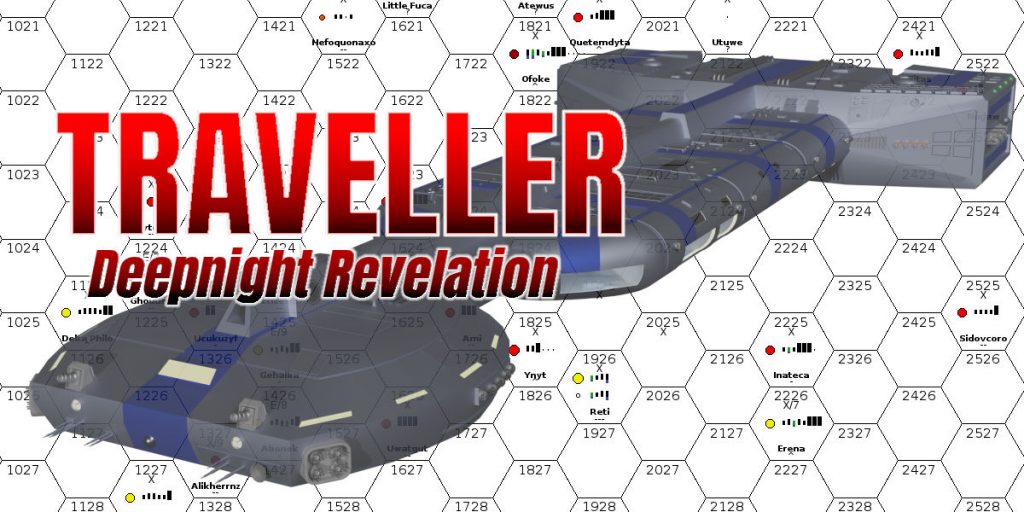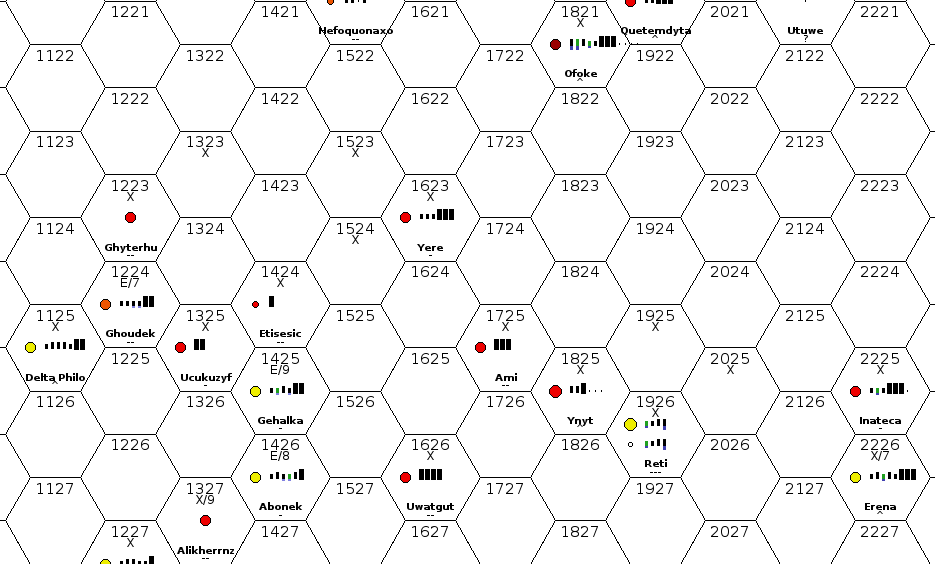Heading to Yonder

In our previous session of Traveller, the crew had discovered an ancient Droyne experiment. It was the final resting place of a Droyne scientist, and was also heavily infected with the Entity that the Deepnight was heading on a mission to find the source of.
Having escaped, they now realised that they needed to go back in. First, because they needed some samples of the agent that was being used to suppress the growth of the Entity, and secondly because they wanted to destroy it.
Whilst they waited aboard the Sex Thing, they doled out heavy weapons to the security team and worked out a plan for getting inside and collecting samples with the minimum level of risk. They had three plasma jets aboard their ship, so enough fire power to take care of most things.
Tooled up as they were, I had difficulty thinking of how to make it risky for them. But given that they were well prepared and had a good plan, I didn’t feel the need to make it dangerous. There would be plenty of time for that sort of thing later.
All they needed from the Deepnight Revelation was a nuke. The ship had 12 1kt nukes and 2 10Mt nukes. The former would be a bit on the small side given the size of the complex (the players did the maths), but the latter would be plenty. Except because they only had two, they didn’t want to use one.
After some discussion, it was decided to rock the place instead. There wasn’t any asteroids in suitably close orbits to the planet, but the Deepnight eventually found one – it would just take 11 days to get out to it, then another 4 days to strap it to the ship firmly enough so they could tow it on a collision course with the target location. As usual the players tried to work out the maths, but I just skipped the detail and assumed what they had would be enough. A small rock travelling at a few thousand kilometres/second would do considerable damage.
With everything planned, it was time to go in.
The entity had spread since they were last in here, with the corpses of several quadrupeds in the oval room. They’d made it about two thirds of the way across before being killed by the ultra violent light. A large mass of tentacles blocked the doorway into the main chamber, burnt and charred where it had pushed a bit too far into the room, but otherwise active.
Three plasma jets made short work of it, allow the crew to enter into the chamber and begin working their way around. Where there was sign of infection they burned it out. Plasmajets are pretty powerful weapons – doing 1D6x10 damage with a 10m blast radius, there wasn’t really much that could stand up to them in the open spaces of the chamber.
Instead of running it as a combat, I just had the three each make an attack roll to see how well they did in keeping things back. They didn’t all succeed, so there was tentacle attack against one of the security personnel. It didn’t get through her armour, and failed to pull her down, so it was burned back without too much difficulty.
In the end they managed to get samples from all six of the chambers, and got out again safely. From there it was back to the Sex Thing, and onto a rendezvous with the Deepnight, watching from a distance as the asteroid smashed into the complex and vapourised a large volume of rock around it.
At this point I did point out to the players that though their Battledress was still doing okay, it was reaching the point where it was suffering from a lack of proper servicing. The Deepnight really didn’t have the facilities to maintain such high tech specialist equipment. There would be a chance of deterioration every time it was taken out and used.
They also still had their jump drive to worry about, and the various other minor issues that were plaguing the ship. There was also now a plan to try and build some more nukes, since two weren’t enough. Though the crew definitely had plenty of people who knew how to do this in theory, nobody had experience in doing it in practice. Yes, they could probably build nukes, but they wouldn’t be as safe, reliable or as efficient as the ones they already have. They wanted to proceed anyway.
From there they headed out of the nebula, stopping at another world that the Droyne had accidentally infected. There was basic organic matter on this planet, and signs of both previous infection and the counter-agent. Though they needed to resupply, they decided not to do that here so would need to find a world with a good (uninfected) biosphere.
Their problem was that there seemed to be few worlds with life in this area of space. This close to the edge of the Great Rift the stellar density was quite low. They would need to head forward, then double back on themselves. Fortunately, as they got closer to the turn point, their sensor readings became more optimistic as they picked up smaller worlds around a red dwarf star. When they got to the system it was found to have a post-oxygen ecosystem. It may only be a type of algae, but it was good enough to load up into their food processors.
By this point deep scanning had picked up something else interesting – a sector ahead of them there were signs of a stellar civilisation. The tell-tale signature of jump drives and radio broadcasts had been detected coming from a region of space several parsecs across. This not only suggested there could be some worlds where they could get decent relaxation, but also a chance to maybe get repairs down on their jump drive.

It took over 100 days to cross the distance from Deepnight Sector to the sector known as Near Side of Yonder. The civilisation seemed to be centred around location 1326, where there were a number of high tech worlds (at least TL 9) which may be a single civilisation or several.
On reaching 1819, a world they named Ghapan, they picked up a closer signal – an apparent distress beacon coming from Ofoke at 1821. The Ofoke system seemed a good candidate to pause at as well, with possibly two habitable planets.
| Distance | Group | Type | Diameter | Atmosphere | Pressure | Hydrographics |
| 0AU | Terrestrial | Tectonic / BathyGaian | 15,500km | Carbon Dioxide | Very Dense | 100% |
| 0AU | Terrestrial | Tectonic / EuGaian | 12,500km | Standard | Standard | 75% |
| 0AU | Terrestrial | Telluric / Cytherean | 12,500km | Carbon Dioxide | Super Dense | |
| 0AU | Dwarf | GeoCyclic / MesoArean | 6,500km | Standard | Standard | 60% |
| 0AU | Dwarf | GeoPassive / Gelidian | 3,000km | Vacuum | None | |
| 0AU | Jovian | DwarfJovian / Saturnian | 111,500km | Hydrogen | Very Dense | |
| 0AU | Jovian | MesoJovian / Jovic | 106,000km | Hydrogen | Very Dense | |
| 0AU | Jovian | SubJovian / Neptunian | 57,000km | Hydrogen | Very Dense | |
| 1AU | SmallBody | 500km | ||||
| 1AU | SmallBody | 500km | ||||
| 1AU | SmallBody | 500km | ||||
| 1AU | SmallBody | 500km |
There were no signs of technology or populations on these worlds, but both had standard atmospheres and liquid water on their surface. The system itself was an oddity – the star was a type L brown dwarf, so the planets were in very close orbit, with possibly an asteroid belt further out.
It would hopefully be a place to rest, re-supply and find out what the beacon was. It would also provide a chance to scan the nearby civilisation some more, before heading in for a closer look at them.
1 Response